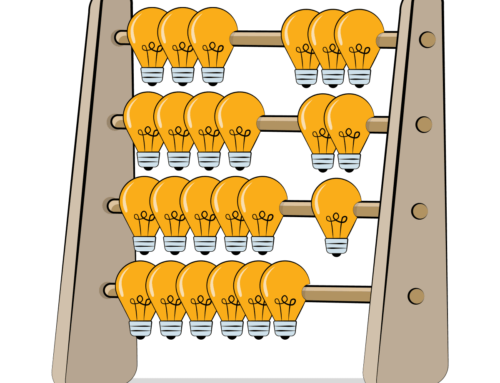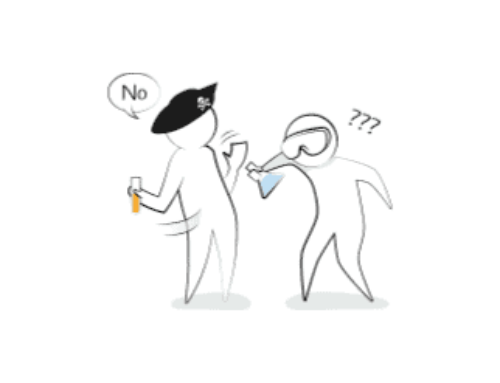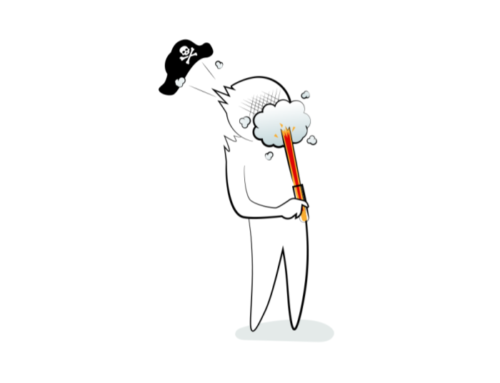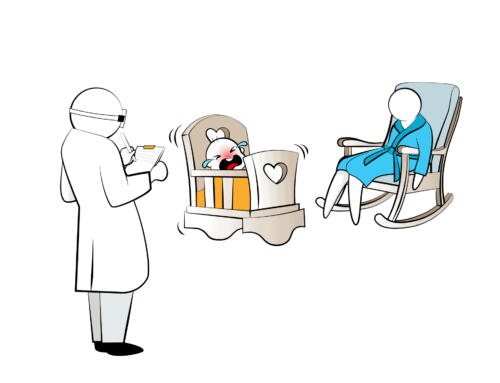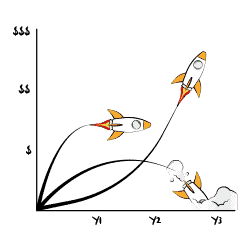Innovation Ecosystem Design Using Liebig’s Law of the Minimum
By Elijah Eilert and Tristan Kromer
Liebig’s Barrel
When governments, corporations, and entrepreneurs start building innovation ecosystems, there’s a flurry of predictable activity.
Create meetups!
Start angel investor groups!
Make sure we have social media accounts tweeting about entrepreneurship!
But all this effort doesn’t necessarily lead to progress. The goal is to increase the pace and viability of innovation activities. Holding meetups doesn’t necessarily do that. We need to figure out which activities will actually have an impact.
To make real progress supporting innovation — whether it’s a country looking to support entrepreneurs or a corporation trying to boost their internal innovation efforts — we need to ruthlessly prioritize.
Prioritizing through Limited Factors
Liebig’s Law of the Minimum states that “growth is dictated not by total resources available, but by the scarcest resource — the limiting factor.” Carl Sprengel formulated this principle in 1840, describing how to effectively grow plants and crops.
Consider a simple apple tree.

For the tree to grow and produce fruit, it requires water, sun, mineral nutrients, carbon, oxygen, and so on. If the limiting factor for growth is water, then adding more nitrogen will not result in increased growth until enough water is available. In other words, if one of the essential ingredients is deficient, growth will be poor even if all other components are abundant.
We can visualize this principle with “Liebig’s barrel.” If one element is missing, then the water (and potential growth) cannot reach its maximum potential.
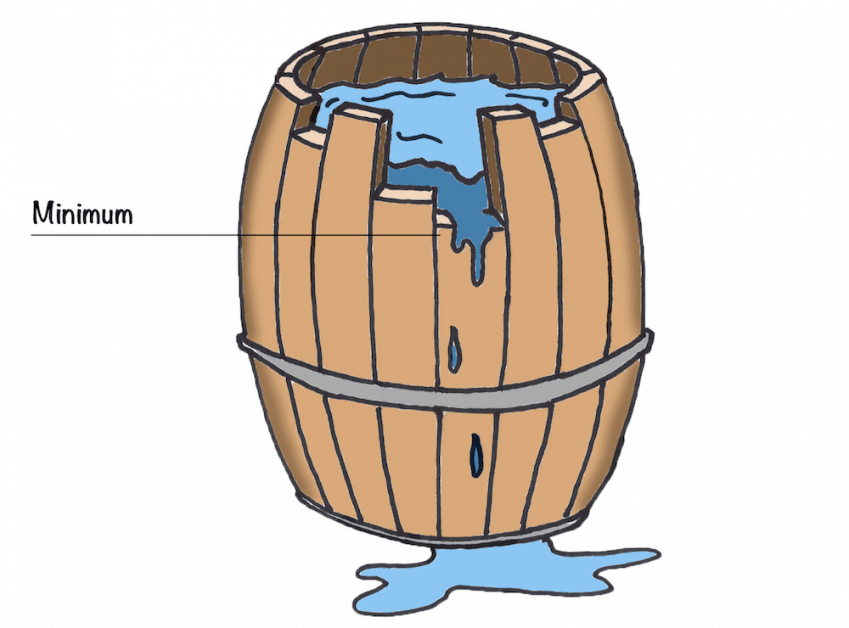
This concept of limiting factors applies equally well to growing innovation ecosystems.
Limiting Elements
Some limiting factors are easily recognizable, such as strategy, decision makers, a network of entrepreneurs, efficient processes, and skills. Others are harder to quantify, intangibles such as inspiration, courage, diplomacy, and reflection.
Some of these obstacles directly limit the growth of startups. If team members in an ecosystem don’t have the courage to propose new ideas, that limits the number of seeds being planted. If a lack of efficiency prevents startups from launching landing pages, then that limits testing ideas. If sponsors won’t fund projects, then nothing can get off the ground.
Like with Liebig’s barrel, these hard limits mean that fixing only one obstacle doesn’t really help. Increasing funding to the R&D budget, for example, won’t pay off if another factor — such as wasteful spending — nullifies the impact of the additional resources.
So what are the true limiting factors?
Ecosystem Elements
There are many different frameworks made up of various ecosystem elements. We’ll focus on two well-known frameworks here that explicitly deal with limiting factors.

AIM by Cris Beswick & Dan Toma
The Assessment for Innovation Maturity (AIM) focuses on the balance between capability and culture. According to AIM creators Cris Beswick and Dan Toma, innovation maturity is made up of five core pillars:
- Strategy
- Leadership
- Management
- Culture
- Processes
AIM analyzes each of these pillars through a comprehensive set of questions, with the limiting factor decided by the lowest score. Breaking each area down into more specific variables helps better reveal the most pressing issue within each pillar, thus identifying precisely the area that needs to be addressed before other components of the ecosystem can effectively work together as a whole.
It’s important to clarify the distinction the creators make between those five pillars. Beswick and Toma researched high-performing innovation organizations and distilled the core, common denominating ingredients into these clustered groups.
The Strategy pillar focuses on an organization-wide understanding of concepts like innovation, the visibility of an innovation strategy, and the clarity around its alignment to the core company strategy.
The Leadership and Management pillars both focus on the people aspect of innovation rather than management. They help unpack whether leadership and management as two distinct layers in an organization are providing the right support, coaching, and environment to foster innovation behavior and contribution.
The Culture component then deals with how people feel about how the pursuit of innovation fits with how the organization operates. Is innovation considered part of everyone’s job? Are roles and responsibilities around innovation clear? What’s the attitude towards collaboration, idea sharing, and risk?
Finally, the Processes pillar focuses on the assets in place that enable organizations to drive innovation. It asks questions about the use of innovation tools, frameworks, measurement, KPIs, and technology.
Each question across these five pillars is then individually scored with more specific questions, corresponding to stages of the maturity curve being weighted differently. Using a simple traffic light (red, amber, green) rating provides an intuitive dashboard for quickly highlighting where an organization’s current innovation barriers lie.
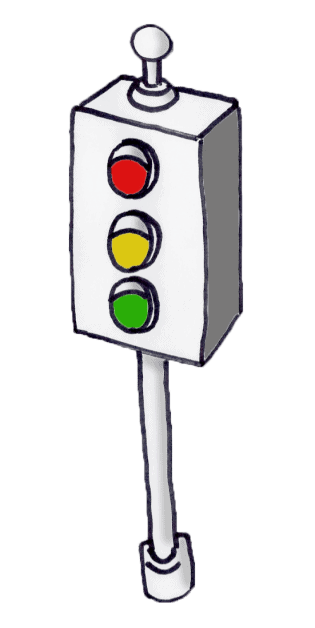
Let’s imagine a company where managers and teams have received significant training in innovation methodologies. If, however, leadership is not actually supporting them in their practice there is very little they can do at scale. For example, failing early (i.e. being able to prove that an idea will likely not succeed early), is of great benefit to the company.
This should be acknowledged rather than punished. If this is not understood by leadership, investment in teams’ and managers’ capabilities to operate in this way can’t really pay off. Leadership has to be addressed before it is sensible to invest more in this capability.
For organizations that want to become more innovative, AIM is a useful tool to identify the inhibiting factors as a guide to better allocating resources, and to continuously monitor what areas of the business need the most support.
Innovation Ecosystem Map by Kromatic
Kromatic’s Innovation Ecosystem Map takes a different approach, looking primarily at the throughput of an innovation funnel. Ideas are created first, and then teams formed around them. Those teams then create innovation options that represent products, services, or business models that can be taken to market and scaled.

Based on this simplified funnel, Kromatic defines 9 elements — 3 of which are considered supporting elements and thus not limiting factors, and 6 that directly impact the throughput and qualify as limiting factors.
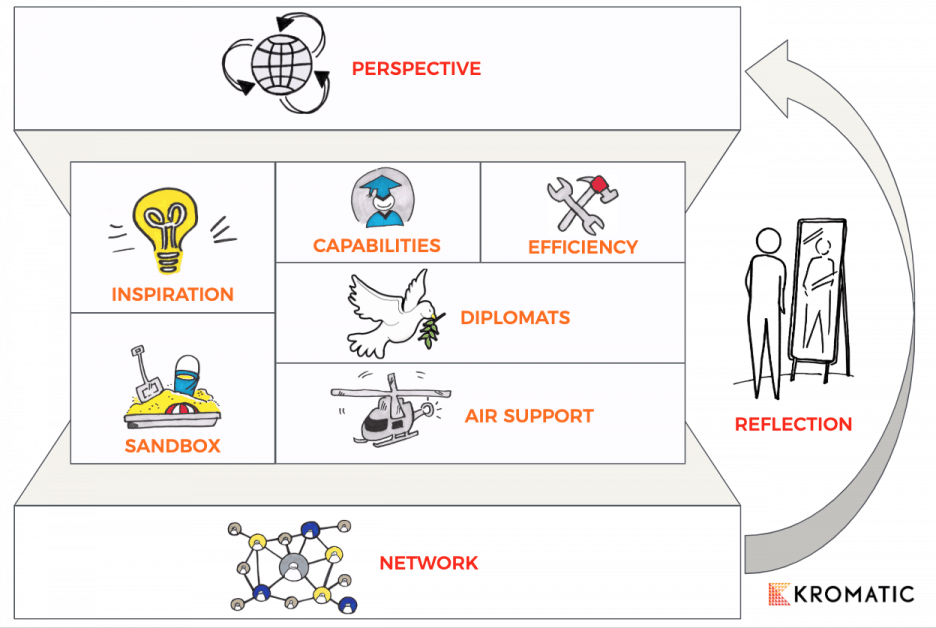
- Inspiration: People need time and space to think and collaborate in order to come up with new ideas. If everyone in the company is 100% occupied conducting business-as-usual, then no one has time to think of new ideas, and innovation is met with apathy, the flip side of inspiration.
- Sandbox: A sandbox is a culture where people have the freedom to fail. In companies that use Zero Based Budgeting, being assigned to a project that gets shut down can get you fired and perhaps ruin your career. That’s not a sandbox, that’s a culture of fear.
- Capabilities: Innovation teams must have the skills and mindset to get a product to market without dependencies on other parties. A software team without a software engineer has a skill gap, making capabilities a limiting factor.
- Diplomats: Every company has politics and fiefdoms that slow things down, but diplomats can cross those boundaries to get things done. If a sales team has siloed itself and will not let the product team talk directly to their customers for fear of losing a sale, a diplomat can save the day.
- Air Support: Resources for innovation projects need to be allocated using different metrics than what works for the core business. C-suite sponsors who require a 60-page business plan with 4 years of financial statements before approving a budget could be considered Dinosaurs, so the lack of Air Support for innovation is limiting the ecosystem.
- Efficiency: Bureaucratic processes need to be minimized and tools need to be readily available. A team subjected to a one month auditing process to justify buying a 3D printer for prototyping purposes is suffering from waste. Such a company needs to seriously rethink their commitment to efficiency.
According to the Kromatic model, some factors only impact certain stages of throughput, and these limits can be traded off against one another.
For example, a software team without a software engineer is lacking Capabilities. But if the team has a good Diplomat, they could “borrow” an engineer from another department.
Alternatively, a company with a skill gap and no good diplomats might rely on Air Support to provide money for an outsourced developer.
Just as a gardener lacking soil could build a hydroponic system, these tradeoffs represent a strategic approach to minimizing the negative impact of limiting factors.
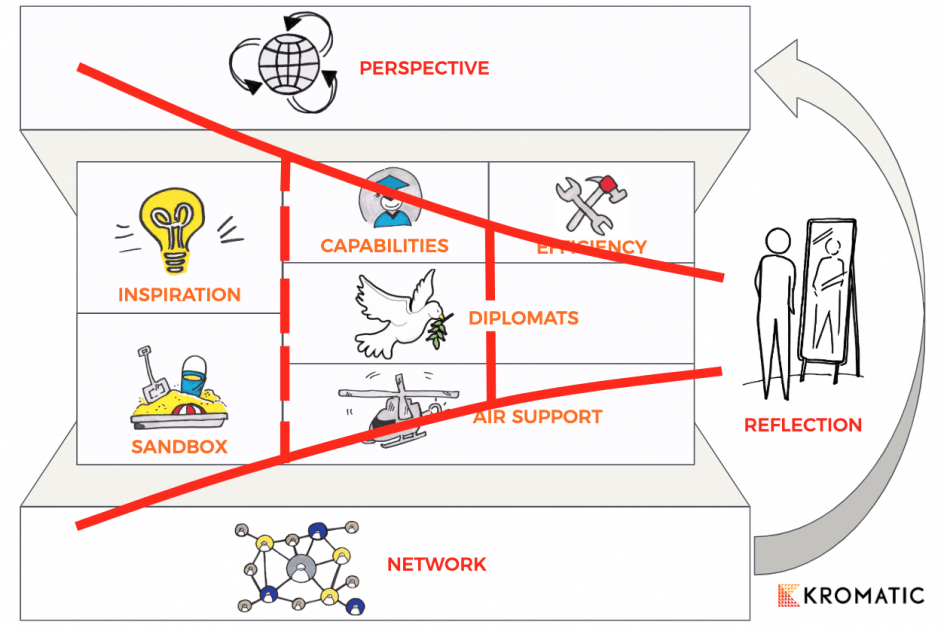
Other Notable Models

There are a number of other models that are well worth reviewing, including:
- Brad Feld Startup Communities
- Ecosystem Canvas
- Culture Canvas by Strategyzer
- Entrepreneurial Ecosystem Building Playbook by Kaufmann
- Ecosystem Pie Model
- Founder Institute Startup Ecosystem Canvas
- Startup Genome – Global Startup Ecosystem Report
Each of these models has its own idea of what elements constitute an innovation ecosystem, or what method you should use to identify potential improvements.
However, most focus on what we should do, without necessarily helping prioritize the thousands of actions we could have taken. When dealing with something as complex as an innovation ecosystem, choosing what we shouldn’t do is as helpful as choosing what we should.
Ecosystem Experiments
No amount of academic analysis or number of frameworks will make a difference if we don’t listen to the data. Ideas need to be tested.
It’s dangerous to kick off a new innovation program promising that everybody’s ideas will suddenly be heard by senior management without providing for what comes next. Is their budget allocated to fund them? Are leaders ready to judge a project with no definitive ROI?
We shouldn’t buy the latest innovation software and collect lots of ideas if there isn’t a plan in place to make sure those ideas are properly curated and tested. That can’t be done unless we recognize the factors that are limiting that innovation ecosystem the most.
Prioritizing our most limiting factors simplifies our decisions about what parts of our ecosystem we should focus on. This allows every innovation activity to be measured and tested against a hypothesis with a well designed experiment. Constant testing of our assumptions will help us identify our weak points and guide us toward the initiatives that will shore up our most limiting factors and generate the healthiest innovation ecosystem possible.
As always, our best bet when starting out is to not worry about what framework to use, but to get started by talking to people. Conducting interviews and asking the right customer discovery questions of those working within the ecosystem is the best way to find the limiting factors in your ecosystem.
Lessons Learned
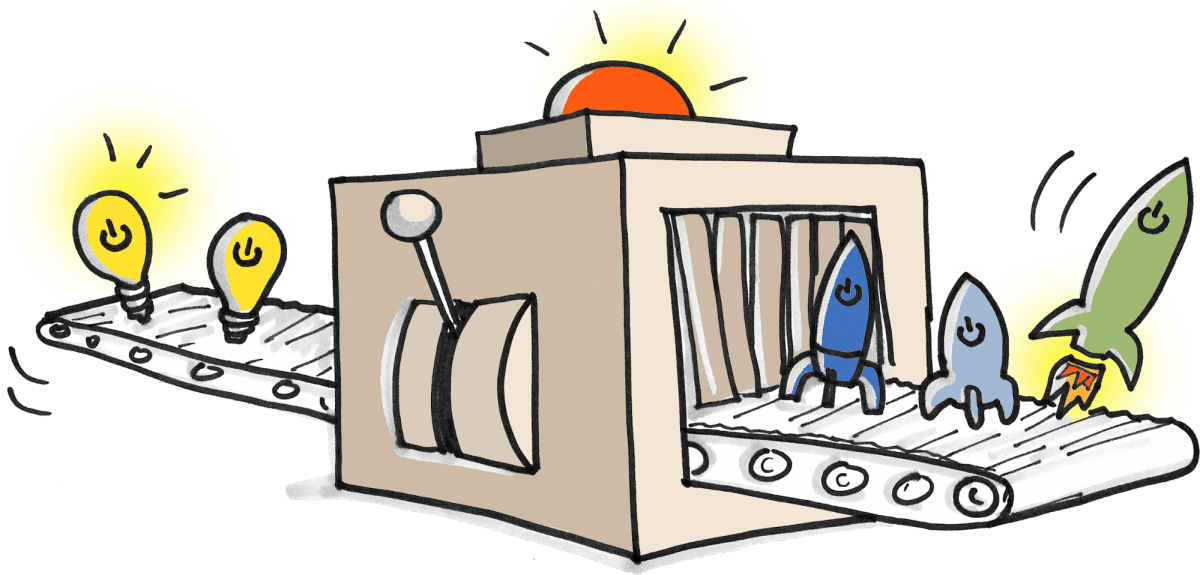
- Limiting factors constrain the growth of an innovation ecosystem.
- Identify all limiting factors (and tradeoffs) before over-investing in any specific activity.
- Focus only on the biggest limitation.
- Measure and assess the impact of reducing the limitation. As soon as the greatest limitation has shifted to another area, switch focus.
This article was first published on Kromatics website – our partner organisation.



